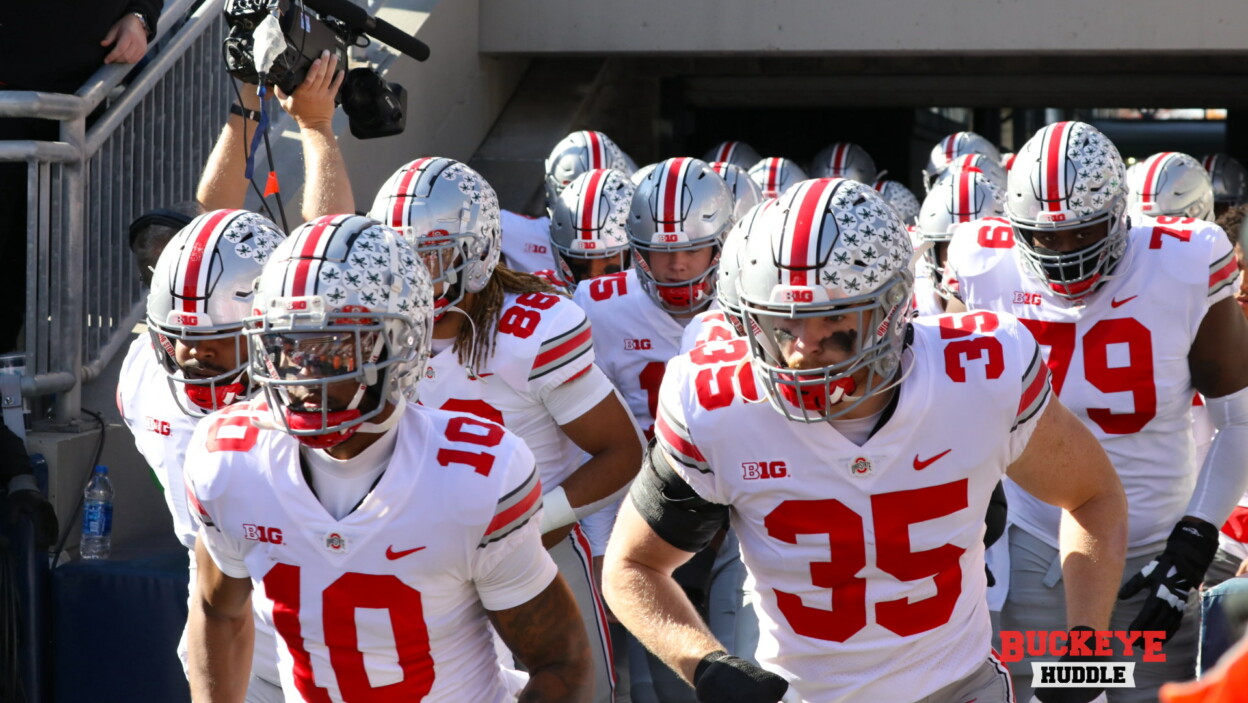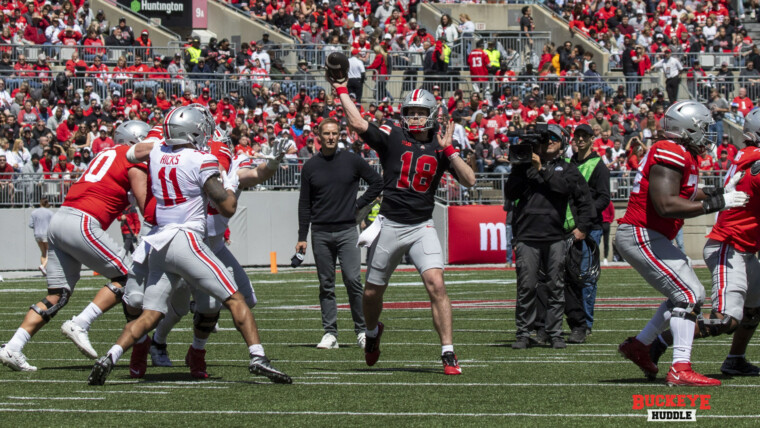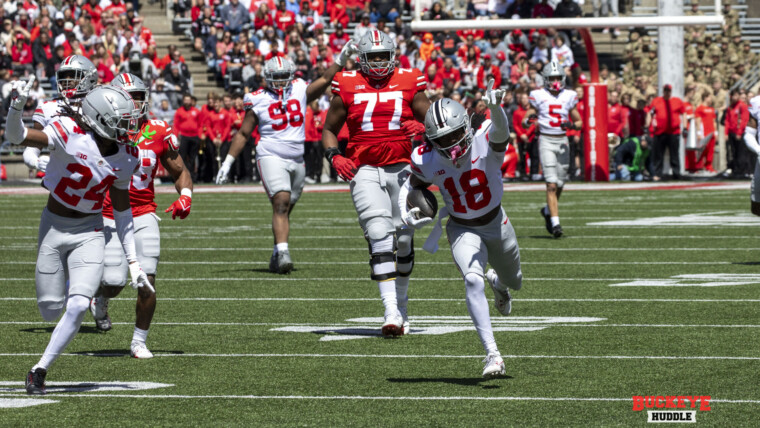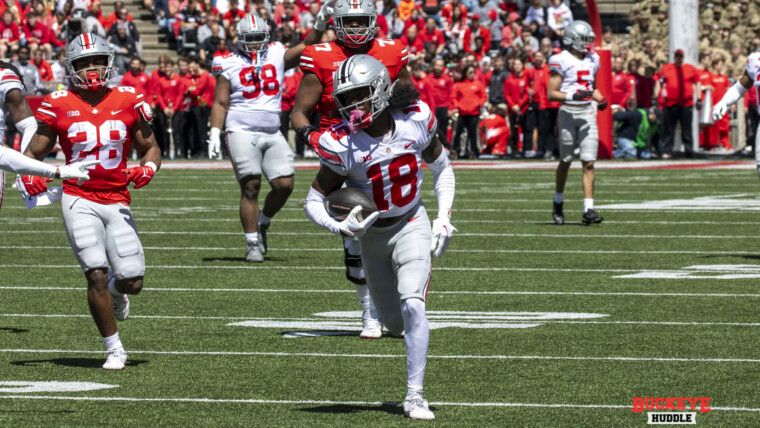Ohio State again started slow offensively against Penn State defensive coordinator Manny Diaz’s myriad of disguise and schemes before a fourth quarter explosion spurred the Buckeyes’ 44-31 victory.
Diaz principally used trap cover 2 (meaning that the corner reads the inside receiver—if he releases to the flat he will jump the route, while if he releases vertically the corner sinks deeper) from both four and five man pressures.
Diaz interspersed that and other two high coverages with cover 1 and cover 0 man looks—using extensive amounts of mugged up linebackers to dictate pass protection.
For example below, Penn State shows cover 2 before rotating to cover one cross, leaving Marvin Harrison Jr. singled up outside.
Diaz’s heavy use of trap cover 2 slowed down Ohio State’s wide receiver screen game.
Ohio State generally throws such screens as a pre-snap relief—meaning that if CJ Stroud sees that he has a numbers or pre-snap leverage advantage he will pull from the run play and throw. But Penn State repeatedly gave an out-leveraged look pre-snap but had the corner attack downhill without worry about vertical responsibility. Here, Stroud has 3 on 2 to the perimeter. But the trap 2 corner is reading inside and beats the block.
Yet Ryan Day also called two unsuccessful automatic bubble screens on third and medium where Ohio State had advantageous numbers. Below he did so against the Nittany Lions’ soft cover 0 concept—perhaps thinking with space that one block would result in a first down (which is likely the case if Cade Stover secures his responsibility).
Although Diaz’s scheme was designed to limit such throws, the lack of success was principally a result of poor execution. As most such bubbles are reliefs, the Buckeyes must execute wide receiver screen blocks in space to protect against being outnumbered in the run game.
And Day did set up a fake bubble and go, where Penn State was able to hold up Emeka Egbuka enough, resulting in Stroud’s pass being slightly overthrown.
Diaz likewise slowed down Ohio State base boundary stretch game by repeatedly using what Dave Aranda calls a “Mex” simulated pressure.
In Mex, the defensive end provides a soft edge, the nose guard loops out to the B-gap between the guard and tackle, and the playside inside linebacker attacks the A-gap—limiting double team blocks, cutting off the running back’s path, and allowing the backside linebacker to loop over unblocked (again, below Stroud should be throwing the bubble).
Ohio State too often failed in their zone blocking identification against this and the Nittany Lions’ frequent boundary slanting and pressures. In particular, the Buckeyes were often too eager to get playside before establishing combination blocks on slanting defensive tackles—repeatedly allowing interior penetration. For example, below on this third and one lead zone run, center Luke Wypler immediately releases to the Mike, leaving right guard Matt Jones trying to cut off the backside one-technique slanting to the short field (although TreVeyon Henderson may have still gotten the first if he followed his blocking).
Henderson likewise often needed to be more patient and keep his feet under him before getting upfield. Here, Ohio State had stretched blocked but Henderson trips cutting back.
Similarly, below, the Buckeyes run same side toss stretch. While left tackle Paris Johnson did not establish his block at the point of attack, Henderson could have cut inside for positive yards. But he is not patient enough to let Johnson wash down his block, resulting in him tripping over Johnson’s feet.
Ohio State’s issue was not that every run was getting stopped or even necessarily that they had too many tendencies. For example, their plan seemed to be to run wide zone weak (away from the tight end)—which they executed with some success early.
The Buckeyes also twice ran inside zone from the pistol for eight and nine yards in the first half, which allowed Ohio State to wash down Penn State’s slanting to the short field and provided Henderson the opportunity to get vertical while using wide trips to pull defenders out of the box.
Although the Buckeyes perplexingly never returned to that run concept from the pistol in the second half, they did again run inside zone cab (meaning that the backside tight end base blocks the c-gap) with success on Henderson’s 41-yard touchdown run. Again, Ohio State’s offensive line washed down the slanting front with Henderson making one-cut off those blocks, while C.J. Stroud’s fake held the backside end enough to allow Stover to make two blocks.
Instead, Ohio State’s primary run game problem remains too many runs for zero or negative yards (against Penn State, the Buckeyes had over 46% of runs go for zero or less yards, and over 37% go for five or more yards). Most concerning is that Ohio State has in the last two games lost some of the run game diversity they had demonstrated prior to their bye week.
For example, the Buckeyes did not run a gap-blocking scheme (down blocking with a pulling lineman) outside of pin and pull until running Power O on Henderson’s last touchdown—despite Michigan’s sustained success with such schemes against the Nittany Lions earlier this season. The Buckeyes then ran it again on the final series for 11 yards.
Like inside zone, with Power O, Ohio State could wash down Penn State’s stunting defensive line and take advantage of the Nittany Lion linebackers getting sucked inside.
The Buckeyes likewise lacked the pistol and under center play-action looks that they featured prior to Saturday. For example, in response to duo-indicative looks (wing and short wide receiver motion) Penn State would have their edge defenders jump outside down blocks, resulting in multiple negative plays.
It is fine to have tendencies. Ohio State will always be more run-heavy with a deep tailback because of pass protection limitations from that set. And, as Day noted, Ohio State likely should have continued to run inside zone from pistol on Saturday because of its effectiveness. But an offense must sporadically break tendencies, as the Buckeyes have done a better job of for much of the season prior to Saturday.
But despite those run game struggles, Ohio State still largely moved the football throughout (averaging 7.5 yards per play) driven by Stroud averaging over 10 yards per pass call.
Penn State’s strategy of frequently playing cover 2 with mugged up linebackers often left the middle of the field open. Stroud hit Marvin Harrison Jr. multiple times on a switch route dig concept—below against a cover 2 invert (safety down underneath, corner deep half) fire zone.
Stroud likewise hit Harrison below on a double dig/post concept against cover 2, with the posts holding the safeties, opening the backside dig.
And when Penn State used man concepts, the Buckeye targeted vertically or with in-breaking routes.
The most important, perhaps, was the fourth quarter third and ten conversion to Harrison on a hot route against Diaz’s continued use of a soft cover 0 on passing downs. There, the Nittany Lions did not have an underneath robber defender due to reading Ohio State’s slide protection, which slid left with the right side protected by the hot route.
Day also used Ohio State’s personnel tendencies against Penn State in the passing game, particularly throwing from 12 personnel to engender more aggressive defensive strategies—such as on the seam throw to Egbuka above. The Buckeyes repeatedly utilized Cade Stover against the Nittany Lions’ aggressive linebackers, such as on another Y-delay for a touchdown.
Similarly below, Ohio State runs a bomber concept with the two tight ends working the middle of the field, leaving Mitch Rossi wide open behind linebackers attacking the line of scrimmage.
Ohio State’s comeback was also aided by an increased use of tempo.
For all the concern about the Buckeye run game, Ohio State is the number one offense in SP+. And the Buckeyes’ primary strength is its passing offense, which is critical, because passing effectiveness leads to explosives and points. While Harrison’s exploits were self-evident, Stroud was also extremely efficient.
The fact that Ohio State averaged nearly double the yards per play passing compared to running (even including the failed wide receiver screens) on Saturday indicates that the Buckeyes should have been throwing the football more throughout—as true balance is gaining about the same number of yards running as passing. There is no need, for instance, for Ohio State to run as frequently as they do on third and short, which continues to short-circuit drives.
Instead, while Day should redouble his efforts to diversify the run and hard play action game he also should rely upon the pass game more to set up the run (as the Buckeyes did on the go ahead touchdown drive)—particularly when teams want to deploy aggressive defensive strategies.
Defensively, against Ohio State’s 4-2-5 defense cover 3 buzz heavy defense, Penn State’s goal was often to use heavy personnel to get a numbers’ advantage to run before throwing off play-action. For example, below, the Nittany Lions use 21 personnel to run lead zone against the Buckeyes’ 4-2-5 under, cover 3 weak with the Will outside the box, providing a numbers’ advantage playside.
Here, Penn State used a trips nub set to force Ohio State’s corner to be the extra box defender.
Similarly, Penn State had repeated success running bash (back sweep away from inside zone) to an unbalanced quads. Below in their odd front, the Buckeyes have three defenders to the field outside the tackle.
By contrast, Ohio State largely controlled the Penn State run game when the Buckeyes could maintain numbers and apply the down buzz safety as the seventh box defender and spill the football.
Ohio State likewise largely limited Penn State’s repeated play action shot attempts from heavy. Below, the Buckeye defenders maintain their deep thirds, while Will Steele Chambers “robots” back underneath.
Similarly, Ohio State’s defensive ends repeatedly created negative plays off of the Nittany Lions’ bootleg attempts.
This included handling motion well against such boot action by either playing cover 1 follow against split action or rocking and rolling against such looks.
But Penn State created several explosive plays in the passing game by creating breakdowns in Ohio State’s cover 3 buzz spot drop route distribution. For example, below, the Nittany Lions run a switch concept. Corner JK Johnson carries the post route to the middle instead of keep outside leverage in his zone.
Penn State then scored on the following play with a similar post-wheel switch concept. Johnson maintained outside leverage despite Parker Washington’s wide split, while middle of the field safety Lathan Ransom did not sufficiently drive on the football.
Ohio State had a similar breakdown in Tampa-2. Chambers as the apex carried number 2 vertically before turning to pass it off to Tommy Eichenberg as the middle of the field “pole runner” but Eichenberg slipped.
Perhaps not coincidentally, Knowles played more loose cover 1 man in the second half, allowing the Buckeyes to handle such switch routes.
J.T. Tuimoloau’s strip sack came off just such a five-across, cover 1 man look.
And the Nittany Lions’ explosive plays were somewhat offset by Ohio State creating turnovers and negative plays with disguise—aided by Tuimoloau’s historic performance.
For example, Tuimoloau’s first interception came off a drop 8 concept.
Although Penn State’s first touchdown came against what was likely too much of a telegraphed cover 0 look, aided by poor “vice” tackling, Knowles at other times caught Penn State through disguising cover 0. For example, below, Knowles showed cover 0, leading to the Nittany Lions checking to a jailbreak screen. But Ohio State then ran cover 2.
And here, Knowles ran cover 0 with a 4-man rush, leaving the linebackers as underneath robbers to limit inside throws.
Ohio State needs to tighten its pass coverage distribution (although some throws are inevitable with Knowles’ run-first approach) and figure out the corner position opposite Denzel Burke. Yet although it was not perfect, Ohio State remains the top team in nearly all advanced metrics, with the top offense and a top 10 defense.








One Reply to Fulton Analysis: Good Enough
Denzel Burke Seeing More And More To Like From Will Howard
Sherrone Moore On Playing Ohio State Multiple Times This Year: ‘Love It. Yes. Let’s Do It’
Ryan Day’s Message For The Michigan Game This Year? ‘Leave No Doubt’
Closer Look: James Peoples Ready For Significant Role This Year?
Big Ten Bluebloods Being Challenged By Oregon
Ryan Day Expecting A Number Of True Freshmen Buckeyes To Play This Year
Sherrone Moore On Playing Ohio State Multiple Times This Year: ‘Love It. Yes. Let’s Do It’
Archie Griffin To Dot The i In Buckeyes’ Season Opener